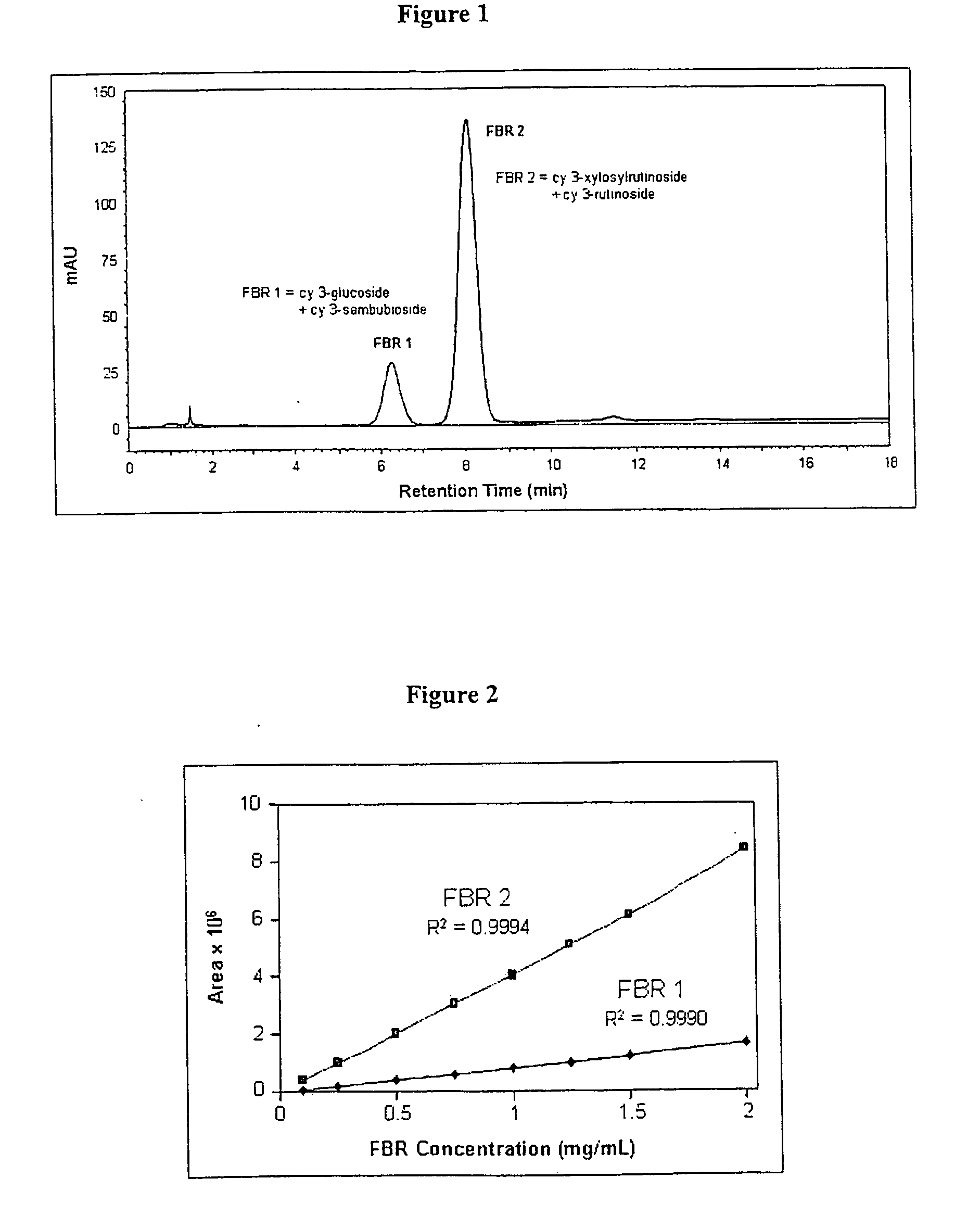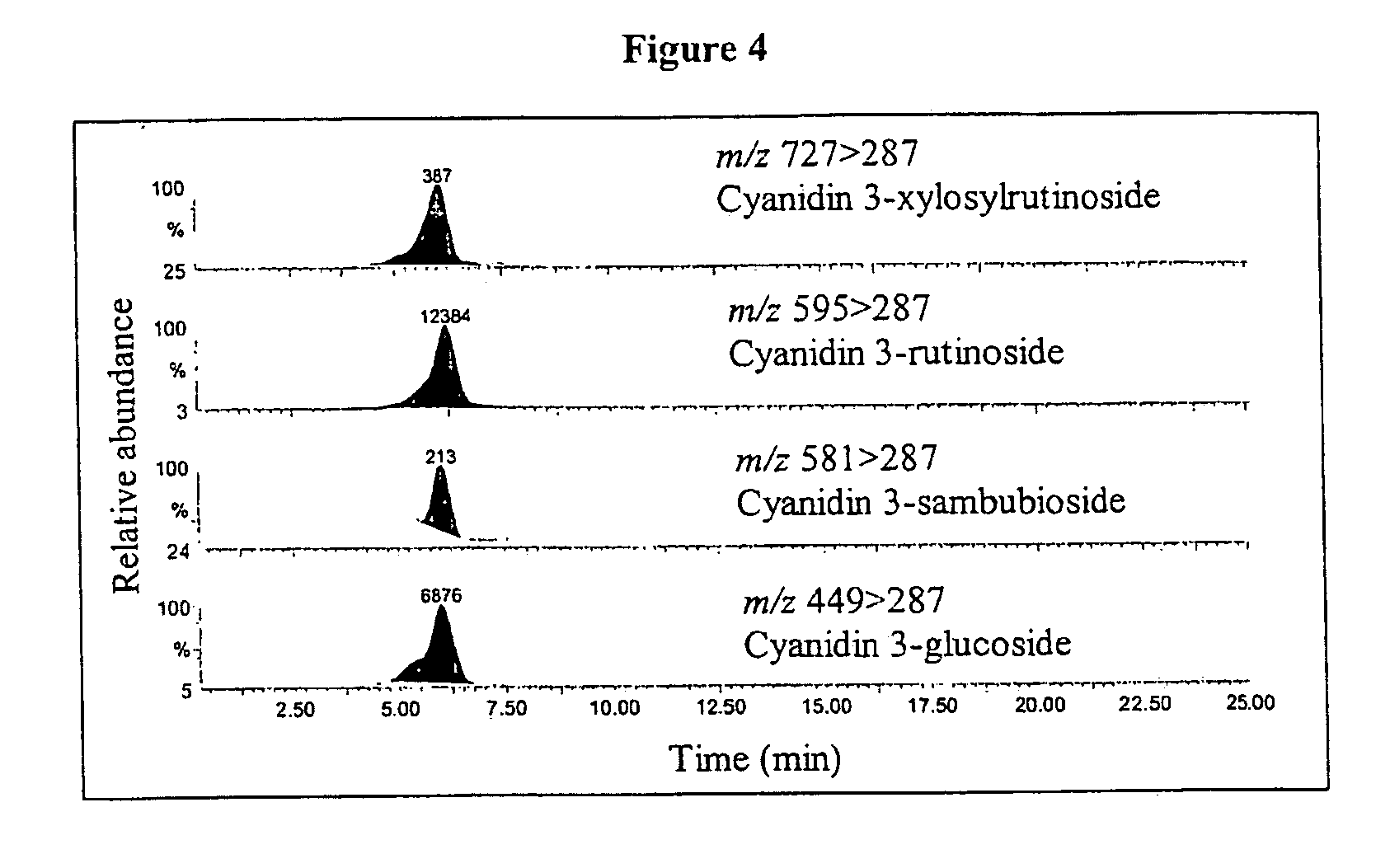Compositions and methods for oral cancer chemoprevention using berry preparations and extracts
- Summary
- Abstract
- Description
- Claims
- Application Information
AI Technical Summary
Benefits of technology
Problems solved by technology
Method used
Image
Examples
example 1
[0030]It was desired to evaluate the effect of pH and concentration of FBR on the efficacy of the compositions and methods of the present invention. Accordingly, various mucoadhesive berry gels varying in final pH and % FBR were prepared for various analyses and in-vivo studies. Five studies were completed as follows: 1) pH 6.5 gels with 5% w / w FBR for a human pharmacokinetic study, 2) pH 6.5 gels with 5% and 10% w / w FBR for anthocyanin uptake studies in human mucosa explant tissue, 3) pH 4.5, 5.5, 6.5, and 7.5 gels with 10% w / w FBR to determine anthocyanin stability at 1 week at 4° C., 25° C., and 40° C., 4) pH 3.5 and pH 4.0 gels with 10% w / w FBR to determine anthocyanin stability over 1 month at 4° C. and 25° C., and 5) pH 3.5 and pH 6.5 gels with 10% w / w FBR to compare difference in anthocyanin uptake into human mucosa explant tissue.
[0031]All gels were prepared in stainless steel vessels using a Caframo Stirrer Model BDC-1850 (Wiarton, Ontario, Canada) with attached metal blade...
example 2
[0036]To quantify and evaluate stability of the anthocyanin composition of FBR gels prepared as described in Example 1, a reversed-phase HPLC assay was developed and partially validated. The HPLC assay was developed based on a previously described assay by Tian et al. [2005]. For the assay, a Thermoquest HPLC system with a UV6000LP photodiode array detector, a Water's Symmetry C18 column (3.9×150 mm, 5 μm), and a Phenomenex Security Guard with C18 cartridge were employed. FBR standards (0-2 mg / mL) were prepared by dissolving FBR in aqueous 1% formic acid (mobile Phase A) and vortexing to completely dissolve the powder. The slightly cloudy standards were filtered through a 0.45 μm hydrophilic PTFE syringe filter into a HPLC vial. A linear gradient (flow rate of 1.0 mL / min) of mobile Phase A (1% formic acid) and mobile phase B (100% acetonitrile) was utilized at a column temperature of 40° C. as follows: 93% A (isocratic) for 0-2 min, 93% A to 89% A (linear gradient) for 2-18 min, 89%...
example 3
[0040]Next, evaluation of anthocyanin uptake into human oral mucosa from FBR gels prepared as described in Example 1 was undertaken. For in-vivo studies, participation of human subjects was conducted in accordance with an IRB approved protocol. None of the human subjects had a diet rich in anthocyanin compounds prior to participation in either the pharmacokinetic or tissue explant studies. For the phamacokinetic analyses, nine consenting adult volunteers dried the anterior floor of their mouth, placed 1.0 g of 5% berry gel (pH 6.5), and massaged the gel in place for 30 seconds to facilitate uptake. Two minutes after gel application saliva was collected for the next three minutes. Peripheral blood was drawn five minutes after gel application. Following clotting, sera samples were collected, and both the sera and saliva samples were stored at −80° C. until LC-MS analysis as described below.
[0041]The human pharmacokinetic studies which used the 5% berry gel (pH 6.5) demonstrated that b...
PUM
 Login to View More
Login to View More Abstract
Description
Claims
Application Information
 Login to View More
Login to View More - R&D
- Intellectual Property
- Life Sciences
- Materials
- Tech Scout
- Unparalleled Data Quality
- Higher Quality Content
- 60% Fewer Hallucinations
Browse by: Latest US Patents, China's latest patents, Technical Efficacy Thesaurus, Application Domain, Technology Topic, Popular Technical Reports.
© 2025 PatSnap. All rights reserved.Legal|Privacy policy|Modern Slavery Act Transparency Statement|Sitemap|About US| Contact US: help@patsnap.com



